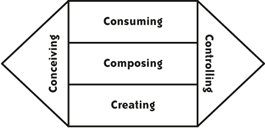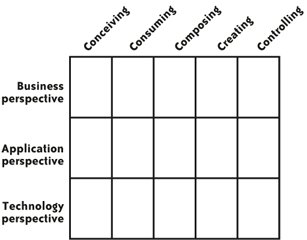Section 1.10. How can ESA be addressed at a tactical level?
1.10. How can ESA be addressed at a tactical level?ESA is a topic with such a wide range and such depth in terms of its effect on IT that it can be difficult to understand where to start. You can find part of the answer by using offerings such as the ESA Adoption Program, explained later in this book, that provides approaches for understanding how ESA can help a business and for creating a long-term roadmap. But on a tactical levelthe level of today's project listESA can be pursued every day. To help understand how ESA can relate to almost every project, it can be useful to think of the five Cs of ESA. These levels are important, because you cannot just push a button and make ESA a part of your business. You must integrate it in steps. Figure 1-20 shows the five tactical levels. The first is conceiving, which involves making sure you know what you want ESA to do. The next is consuming, the task of putting services to work in simple ways to attack projects that are easy to complete. The skills built into consuming services can support the next level, composing, in which more innovative and complex applications based on services are created. The task of composing applications generally starts with existing services, but if the job cannot be done with services already in the repository, then the next tactical level is required. Creating services is perhaps the most technically challenging level, in which you design and create new services by using a variety of development tools. Finally, controlling concerns tactics focused on policies for IT governance related to the security and operational issues surrounding services. Figure 1-20. The tactical levels of ESA Each part of this book will focus on a different tactical level. The goal is that each tactical step will create more flexibility and build more skills. The process of creating a roadmap for ESA (described in Chapter 7) shows how to synchronize all of the tactical work so that infrastructure improvements, software upgrades, system consolidations, and so forth, focus the power of ESA on bringing flexibility and rapid evolution to the parts of a business that will have a strategic impact. The challenge in discussing ESA is that it can bring up many issues at once, and discussions sometimes wander and become confusing because too many topics are in play. One tool for achieving clarity is a map we created for our use in this book. This map combines the five tactical levels with the three architectural perspectives to create the map shown in Figure 1-21. You can use this sort of map to identify quickly the areas that any discussion is touching on so that you can address issues one at a time and with a clear context. Figure 1-21. The ESA map: perspectives and tactics For example, if a businessperson comes up with an idea for a composite application that automates a process across many different lines of business, how can you carry on a discussion about what must be done? One way would be to go through each box in Figure 1-21 and bring up the issues and questions related to each box. Normally, not all boxes apply. At the end of such a process, you will have a to-do list that you can easily allocate to those in charge of each perspective. |
EAN: 2147483647
Pages: 265